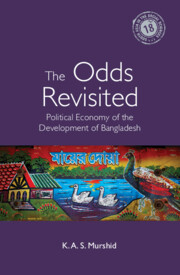Book contents
- Frontmatter
- Dedication
- Contents
- List of Tables and Figures
- Acknowledgements
- List of Abbreviations
- Introduction
- 1 A Bird’s-Eye View of the Bangladesh Economy: 1971–2020
- 2 Initial Conditions: The Odds Revisited
- 3 The Food Security Challenge
- 4 Exploring Transition and Change in the Rice Market
- 5 International Migration
- 6 The Rural Non-farm (RNF) Sector
- 7 Industrialization and the Rise of RMG
- 8 Industrialization: Other Stories
- 9 The Social Sector Puzzle
- 10 Dhaka: Capital Formation—Urbanization, Competition and the Rise of a Business Class
- Conclusion
- Notes
- Glossary
- References
- Index
1 - A Bird’s-Eye View of the Bangladesh Economy: 1971–2020
Published online by Cambridge University Press: 30 June 2022
- Frontmatter
- Dedication
- Contents
- List of Tables and Figures
- Acknowledgements
- List of Abbreviations
- Introduction
- 1 A Bird’s-Eye View of the Bangladesh Economy: 1971–2020
- 2 Initial Conditions: The Odds Revisited
- 3 The Food Security Challenge
- 4 Exploring Transition and Change in the Rice Market
- 5 International Migration
- 6 The Rural Non-farm (RNF) Sector
- 7 Industrialization and the Rise of RMG
- 8 Industrialization: Other Stories
- 9 The Social Sector Puzzle
- 10 Dhaka: Capital Formation—Urbanization, Competition and the Rise of a Business Class
- Conclusion
- Notes
- Glossary
- References
- Index
Summary
The traditional image of Bangladesh as a woefully poor, overpopulated nation plagued by food shortages, natural disasters, massive malnutrition, illiteracy and under-employment has finally receded into the background. The country has now begun to attract attention from the world for its economic performance and potential business opportunities rather than for its poverty and misery. The growth rate for 2018–19 was a record 8.15 per cent. This came down to an estimated 5.24 per cent in 2019–20 as against earlier projections by the government of 8.19 per cent – purportedly due to economic shutdown in the wake of COVID-19. If the official figures are proven correct, the growth rate achieved in 2018–19 is the highest on record for the country and one of the highest in the world.
In terms of per capita income, Bangladesh became a lower-middle-income country in 2015 and is on track to graduate out of the least developed country (LDC) status by 2024, after all three indicators for crossing the initial threshold were met in 2018 – the only LDC in Asia–Pacific to have done so (Murshid 2019). Per capita income in 2019 was USD 1856, and the country has set ambitious targets to become an upper-middle-income country and a developed country by 2031 and 2041. That the country can dream to become a high-income country by 2041 itself speaks volumes about its confidence and ‘can-do’ mindset – a far cry from the hand-to-mouth existence of the early years when foreign aid was the only way to make ends meet.
Growth
In general, the growth rate has steadily climbed, displaying quite a lot of variability in the 1970s, with a great deal of year-to-year fluctuation. The instability is clear from Figure 1.1, where we see that it persisted into 1981–82 before entering into a long, unbroken period of stable growth. Growth in the 1980s was low, hovering around the 3.5–4.0 per cent mark but gradually crawling up to reach just over 5 per cent on average during 1995–2000. By 2005, another 0.5 percentage point was added, with the trend continuing to top 6 and then 7 per cent in 2005 and 2015. Bangladesh's growth performance appears remarkably stable, especially after 2003 – a feature that is also borne out in comparison with that of neighbouring countries.
- Type
- Chapter
- Information
- The Odds RevisitedPolitical Economy of the Development of Bangladesh, pp. 8 - 36Publisher: Cambridge University PressPrint publication year: 2022



